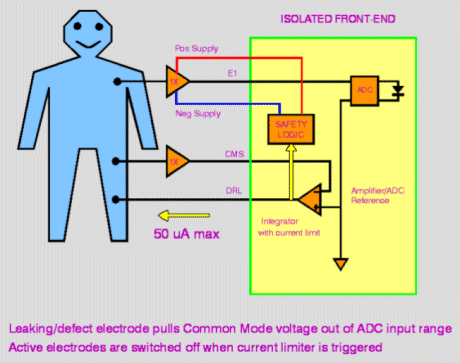|
All
our systems (ActiveTwo, ActiveOne, Mark-8 and the Mark-6) have
a Driven Right Leg circuit with current limiter. Besides reducing
the Common Mode voltage, the DRL also protects the subject for
defects in the amplifier. If one of the input stages in the Active
electrodes would break down, and the electrode input would become
shorted to one of the Active electrode supply rails (0V or 4V),
the current limiting resistor in the DRL protects the subject.
In the very unlikely case that two Active electrodes would fail
simultanously and that one electrode would be connected to the
0V and the other electrode would be connected to the 4V then dangerous
current would be possible in spite of the DRL current limiter.
Therefor we have integrated an extra protection in the ActiveTwo
AD-box which only enables the powers when no errors are detected.
(see diagram below)
The
subject is protected for leakage currents from the mains supply
by the isolation barrier between the amplifier and the PC: the
optical fiber data-link combined with battery power supply provides
complete safety. Leakage currents are well below the measurement
accuracy (< 1 uA). In case of the optional mains supply, the low
capacitance of the used DC-DC converters limits the currents to
less than 10 uA (with the BioSemi 128-channel system, the actual
measurement was 2 uA with the subject touching the 220V/50Hz mains
supply, the isolation capacitance of the DC-DC converter is approx.
30 pF per 128 channels).
The
DRL provides an additional safeguard for mains supply currents
when someone would by mistake make a ground (earth) connection
to the amplifier. Please note that this would be very difficult,
since the "saboteur" would have to open the cabinet to do this
since all conductors on the outside of the cabinet are either
electrode inputs or protected shield outputs.
|







